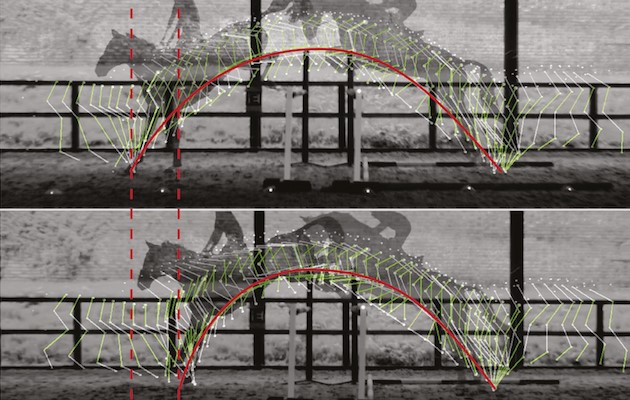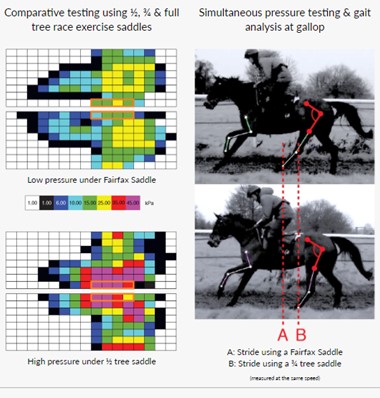Warning: number_format() expects parameter 1 to be float, string given in /var/www/wordpress/wp-includes/functions.php on line 425
Nowadays, the influence of equipment on racehorses’ performance may seem secondary. However, scientific studies have looked at the equipment pressure impact on a horse’s performance, both in racing and training. Inadequate equipment could lead to a change in locomotion during intense effort, which could be synonymous with pathological development in the long term.
How does equipment influence the performance and health of racehorses?
1. How does equipment affect racehorses?
This article considers the equipment as the set of materials used for training racehorses, systematically consisting of a saddle, at least one rug, a harness, and sometimes a chasing collar or breastplate. This equipment creates pressure points in the horse that affect its performance.
Pressure points created by the saddle
Today, in most racing stables, each saddle is given to a training rider and not to each horse. Due to the horse racing stables’ turnover and growth, it can be challenging to fit a saddle specifically to each horse. An ill-fitting saddle does not distribute the rider’s weight properly. Pressure points can arise. During high-speed efforts, these pressure points can become uncomfortable for the horse and lead him to compensate for this discomfort by changing his locomotion.
To check if the saddle is suitable for your horse, there is an easy way: make sure that the sweat under the saddle after work is even. If it is not, you will notice dry patches, which means that the pressure in that area was such that the blood flow was impaired. The muscle tissue and the glands accountable for sweat could not function. These are symptoms that can indicate saddle-induced back pain.
By improving the padding quality, it is possible to rebalance the saddle position on the horse. Not only that, but the shape of the pommel is also important to reduce pressure areas.
Comparative study between four saddles with different types of pommels

Reducing the pressure (2021). Trainer Magazine, 73, 56-60.
http://www.trainermagazine.com).
We can see that the pressure exerted on the horse’s back by the half saddle is more than 45 kPa around the withers. This matches to a force of 459 grams per cm².
The ¾-horse pommel saddle has an asymmetric pressure distribution around the withers, with the pressure concentrated on the right side.
The full pommel saddle has a more symmetrical pressure distribution over a larger area than the first two, but the pressure around the withers is present.
The FairFax pommel saddle has hardly any pressure points above 25 kPa (255 g/cm²).
Stride analysis reveals that a better hindquarters engagement happens when the withers are released. This better engagement results from a better functioning of the horse’s back which reflects improved muscle work.
Thus, there is a potential for improvement in the manufacture of saddles usually used in training.
Freedom of the back and withers is essential to allow the horse to express his potential.
Pressure points generated by the pad
To compensate for this saddle fit problem, people usually use several pads. However, there is no evidence proving this method’s efficiency. The layering creates a greater thickness between the saddle and the horse. It does not systematically release the vertical spine and withers. The overlapping of the rugs also causes the jockey to move away from the horse. It can create a feeling of imbalance and a tendency to tighten the girth more. It can limit the horse’s ability to breathe during exercise. It is advisable to limit the overlapping rugs use. Using only one suitable pad is more effective than using several that may pinch the withers and spine.
A study has compared the effectiveness of different pads (Scientific research quantifies the impact pads have on the horse’s performance. (2021). Trainer, 72, 52-56. http://www.trainermagazine.com). It shows that a foam pad absorbs pressure 65% better than a gel pad. A polyfill pad (Puffer pad) absorbs shock 44% better than a gel pad.
When the jockey is balanced, 90% of his weight concentrates around the withers. This area is sensitive to pressure as the withers are the origin of many muscles related to locomotion. The shape of the mat is also essential. A mat with a straight backline tends to press on the backline. There are anatomical rugs on the market with a straight backline that prevents the rug from compressing the withers.
Pressure points generated by the breast band
Used mainly as a safety device to keep the saddle in place, the breast band and hunting collar impact the forehand.
Indeed, a study has shown that a breastplate or breast collar can negatively affect the horse’s stride (Scientific research uncovers how breastplates & breast girths can inhibit performance. (2021). Trainer, 74, 56-60. http://www.trainermagazine.com). This study focuses on show jumping horses.
In the picture below, we can compare the jump trajectory with and without a chasing collar. We can see that the jump’s course with the collar is shortened, the landing is closer to the obstacle.

Jump trajectory analysis with and without chase collar
(Scientific research uncovers how breastplates & breast girths can inhibit performance. (2021). Trainer, 74, 56‑60)
In comparison, the horse lands 0.5m further away when jumping at the height of 1.20m without a collar. It can thus calculate that in a race of 12 obstacles, the horse equipped with a collar could lose about 6m of the ground. This 6m is the distance that does not cover by the jumps. Furthermore, this study suggests that the canter stride itself is shortened in addition to the quality of the jumps. Finally, if the brace is poorly adjusted, it can press on the trachea and interfere with breathing. The lack of oxygen can then increase the risk of fatigue.
2. Increased injury risk
Racing saddles, used occasionally, have no real, quantifiable impact or influence on racehorses’ performance and health. Training saddles, on the other hand, have a significant influence. The horse must fully possess his speed capacity during the race, so it is essential not to overload his withers and his spine.
To increase speed, the horse changes two factors: his stride frequency and his stride length. Naturally, to limit energy expenditure, the horse increases his stride length and then accelerates its stride frequency to reach its maximum speed. However, when the saddle discomforts the back muscles, the horse cannot get his full stride length and compensates with a higher increase in stride frequency; he rushes. This increase in pace can therefore increase the risk of injury.
A study (Scientific research quantifies the different impact pads have on the horse’s performance. (2021). Trainer, 72, 52-56.) considers that pressure of more than 35 kPa compresses capillaries and degrades soft tissue such as muscle tissue. It would take 100,000 galloping strides to damage soft tissue under such pressure, according to this study.
Compression of the trachea and/or rib cage impairs the horse’s respiratory capacity and leads to early fatigue during intense effort (racing).
EQUIMETRE’s role in detecting a change in locomotion
EQUIMETRE will not be able to determine if the equipment is suitable for your horse. However, it can identify a change in locomotion by measuring stride length and stride frequency.

These data show a slight degradation of locomotion. Indeed, when training at the same speed, the horse lost about 25cm of action. This shortening correlates with poor recovery. These data may raise a concern or discomfort for the horse.
In addition, the data provides a comparative tool to determine if the equipment is suitable. By analysing locomotion through the measurement of stride amplitude and cadence, comparative tests can be carried out. By changing parameters such as pad type, girth intensity, saddle, bridle and breastplate settings and by checking the quality of the cadence and amplitude each time, it may be possible to determine the most suitable combination for the horse.
Keywords: racehorse performance, racehorse health, equipment racehorse, data, racehorse training




